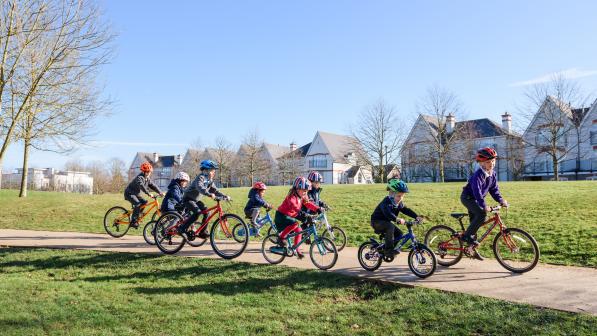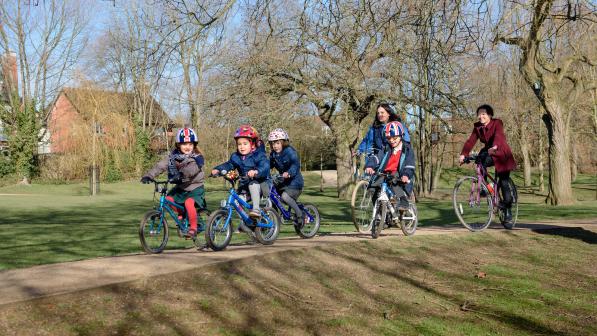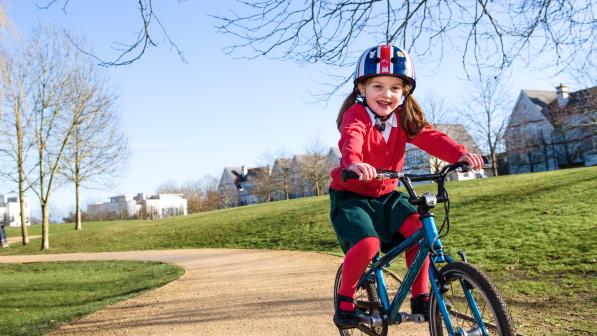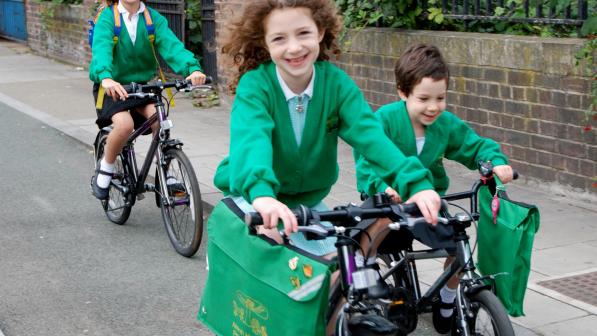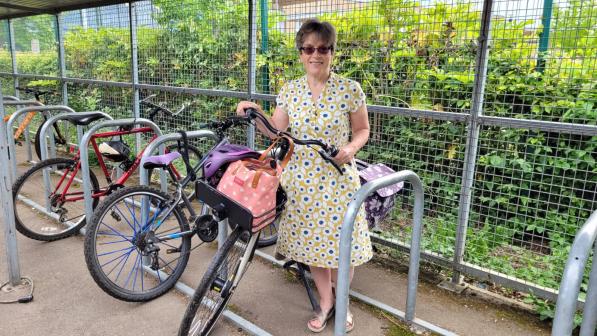Cycling for the school run

About the campaign
Are your school gates open not only to children, but also their cycles? Cycling UK finds that some gates are – and some are not.
We believe that all schools should welcome anyone who wants to cycle there and back: children, parents, staff and visitors alike.
But the decision to cycle for the school run factors in more than the cycle friendliness or otherwise of the school. Worries about hostile road conditions along the route make it very difficult for many adults to make the call about whether to encourage any child to cycle commute.
Ironically, much of the traffic flooding local roads from 8-9am is generated by people taking children to school. Some headteachers and governors even cite congestion around their school gates as one of their reasons for not wanting children to cycle there.
Yet cycling is one of the solutions, not the problem, both for peak-time traffic havoc round the premises, and for the impact that the travel habits of the school community have on the wider locality and its residents, as well as on children’s health (excess weight and obesity, for example).
Currently, more than half of children travel inactively to school. Of those who travel actively, most walk and only a very small proportion cycle, typically:
- England (5-16 year-olds) – 2%
- Wales (primary school children) – 2%
- Scotland (all schools, two different surveys) – 2%/4%
- Northern Ireland (4-18 year-olds) – 1%
For more detail, including trends, see Cycling UK’s Cycling Statistics.
The tiny percentage of children riding their bikes to school is a shame, and not just because car-borne youngsters are missing out on the physical activity and all the other benefits
Walking is a sensible option if the site is just round the corner from home. But, if it’s further away – and, for most families, it’ll only be two to three miles – cycling will eat up the distance. The trip will also be much healthier and greener than being ferried in a car, not to mention more fun.
What’s more, it’ll be a learning experience, an opportunity for independent travel, along with the confidence and sense of achievement that accompanies it, and lessons in road craft, navigation and the geography of the local area.
The tiny percentage of children riding their bikes to school is a shame, and not just because car-borne youngsters are missing out on the physical activity and all the other benefits.
It’s also a shame because learning at an early age to see cycling as viable transport for short local trips makes it more likely that it’ll turn into a habit for life, tackling car dependency in adulthood and, indeed, the relentless growth of motor traffic that we must halt and reverse for everyone’s sake.

What can we do about this?
Cycling UK believes that the answer lies in schools:
- Involving the entire school community in building and uniting behind a cycling culture, from the youngest pupil to the most senior governor
- Developing, acting on and monitoring School Travel Plans with cycling at their core
- Publishing pro-cycling policies
- Arranging for cycle training (usually Bikeability – England, Scotland)
- Organising other activities and projects to promote safe, fun and responsible cycling. (Bikes and bike riding can be a hook for geography, art, design and technology, history and citizenship lessons)
- Providing high-quality facilities on school premises for pupils who cycle (parking, lockers for equipment and so on)
- Removing all barriers to cycling (bans on parking cycles on the premises, draconian permit or licensing systems, for example)
- Not imposing restrictions on those who do cycle (such as ‘banning’ children from cycling if they don’t have or wear a helmet)
- Working with the local highways authority to improve road safety in the area, introducing school streets and enforcing them

The answer also lies in local councils:
- Working positively with schools about cycling and offering resources to help them develop their Travel Plans
- Jointly identifying hostile conditions on local roads and treating them to help make cycling to and from school as hazard free, attractive and convenient as possible; for example, by adopting 20mph speed limits, building safe cycling links, and introducing school streets and enforcing them
- Supporting schools by providing free, high-quality cycle training
We also believe that inspections and self-evaluations should assess schools on what they’re doing for active travel and steps taken to minimise their impact on local traffic volumes and road danger.
Creating an Active Travel School is entirely possible – read about Ysgol Hamadryad in Cardiff, which opened in January 2019.
See Modeshift STARS for further case studies, and advice on creating travel plans.
The articles below go into more detail and include 10 top tips for cycling to school, the case for cycling to school and how to overturn a school’s anti-cycling policies (such as what to do about ‘bans’).
